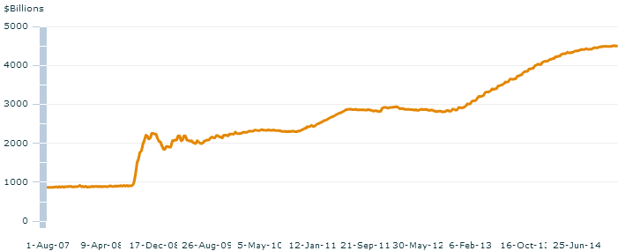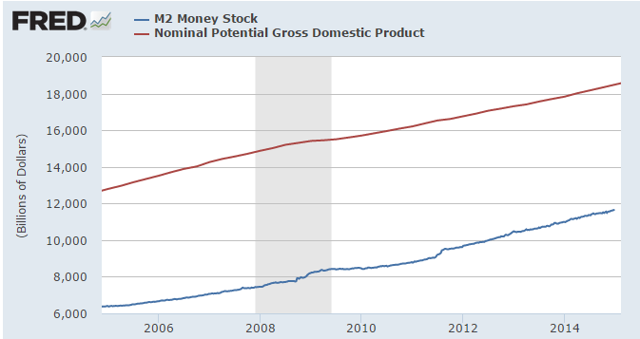Summary
- Price of gold has very little downside left due to $1,200 being price level needed to keep current mine production going.
- Many factors, such as volatility, large piles of printed money, sideways trading stock market all bode well for gold.
- Some possible headwinds, such as stronger US dollar, but so far, it has not affected price of gold.
Emerging market central banks net buyers (China & Russia).
It has become clear for the past few years that China, and Russia are increasingly looking to boost their gold reserves. Even though China did not make an official statement in regards to an increase in its gold reserves held by the central bank, in 2013 it did import and produce more gold than was consumed by non-government consumers. It seems as much as 500 tons may have gone into Chinese vaults for storage that year. At least as much might have gone into central bank storage in 2014 as some estimates put Chinese net imports of gold for last year at perhaps 1350 tons (link).
Russia's central bank has been boosting its gold reserves in 2014, even as its overall FX reserves have been declining. In September alone, it increased its reserves by 37 tons (link). it seems many other central banks around the world decided to increase their holdings of gold in 2014, aside from Ukraine, which it seems may have been persuaded to do away with its own gold reserves (link).
What this all means to the gold market is that regardless of whether the 2013 gold crash was masterminded as many people suspect by Western central banks together with a handful of banking institutions such as Goldman Sachs, or perhaps it just happened because people no longer saw gold as a good momentum bet, there is very little growth in the amount of gold available in the Western world, which will make it harder to repeat such a drop in the price of gold again.
Gold's main competitor, stocks no longer look to surge.
As I pointed out in other previous articles, I believe that one of the main factors that led to investors dumping gold was the fact that after it reached $1,900 an ounce, they felt that it had very limited potential upside still left. In the meantime, stocks were on a tear that started at the end of 2009 and at the time when the price of gold started declining from its record high, the stock market was still going strong. Now, we increasingly see more and more sideways momentum in stocks. Furthermore, we are now eight years away from the start of the great financial crisis, which means that we are more or less due for another recession given the average length of economic cycles in the past few decades. In conclusion, the returns on stocks not likely to be as enticing as before, therefore holders of gold will no longer be tempted to sell in order to get into assets with a higher rate of return.
Global fiat currency supply continues to increase.
Since the beginning of the financial crisis the US Federal Reserve's balance sheet has more than quadrupled.
(click to enlarge)

Source. Federal Reserve.
As we can see from the graph, the Federal Reserve has been busy printing money and exchanging it for other assets. But most of this money did not actually make it into circulation. In fact, the money supply in the economy pretty much kept pace with nominal growth more or less.
(click to enlarge)

Source. Federal Reserve St. Louis.
The fact that most of this money did not make it into the real economy is what thwarted the theories of currency debasement and hyperinflation coming due to all the money printing. We have to realize however that the money that has been printed is still around, mainly parked in banks and for the Federal Reserve to start shrinking that balance sheet, if it needs to in order to fight back a flare-up in inflation, it would have to start selling assets from its balance sheets that may not necessarily be very desirable in the market. That was the main reason those assets were parked there in the first place.
I think the money that has been printed and used to shore up the banks may at any point start chasing certain assets such as commodities for instance, causing inflation to pick up in the economy. If such an event will come to pass, it is hard to see how the Federal Reserve would go about controlling inflation given that all the money printed in recent years will chase the assets with the best potential return. The assets currently on the Fed balance sheet will most likely fail to compete with a surging price of oil for instance.
Similar problems can be encountered with other major central banks, such as that of Japan which nearly doubled the size of its balance sheet in the past year or so (link). The ECB is increasingly expected to start an aggressive expansion of its own balance sheet in order to deal with the Euro zone's problems.
Strong US dollar and falling oil prices did not take gold down in past months.
Ordinarily a strong US dollar tends to discourage gold buying, because strength in the world's most important fiat currency suggests that there is overall confidence in paper assets. A weak oil price also tends to drag gold prices down with it, because there is a historical correlation between the two that rarely breaks down. In the past few months however, the two seem to have decoupled. If this relationship will continue to stay decoupled, it could signal the beginning of a bull market in gold in my opinion because traders will no longer link its momentum to that of oil. This is very important because as I often stated, oil prices above $100 a barrel are not economically sustainable, therefore upward momentum is limited and as long as the two traded together, there was a limit to the price of gold as well.
Low bond yields.
An important factor that should make gold a long-term investment attraction is the low yield on debt. Investors have been chasing interest returns for a few years now, causing them to increasingly accept relatively high risk for relatively low rewards. One such example is the high yield debt in the shale oil & gas sector, which is now all the sudden looking shaky (link). Even Italian ten year bonds, which in my view is a relatively high risk asset only yields 1.7% and for investors outside the Euro zone, it also presents a currency risk (link).
Some headwinds in 2015.
Even though it has not been the case so far, there is reason to expect that the strength of the US dollar will dampen demand for gold as an investment. Demand for gold may also be dampened by a worsening of economic conditions in places such as Russia. Given that Russia is burning through its FX reserves, it may not make much sense to continue stockpiling gold just now, because there may come a time to have to sell again before the price of oil recovers significantly enough to help stop the shrinking of its reserve pile.
Even so, I expect 2015 will be a decent year for gold. Given that it closed below $1,200 in 2014, it stands a good chance of closing above that level for 2015. A decent gain in price should reignite the interest of traders. There is also a good chance of the safety trade reigniting as there are many sources of volatility, ranging from default risks, such as Ukraine, and some oil companies, to perhaps some holders of oil hedges or debt. The continued difficulty in the EU economy is also a reason to worry in my opinion as it continues to give rise to increased support to fringe political elements. Aside from that, we are now headed closer and closer to the window of expectations for another recession given the expected average length of economic cycles. I personally expect that it will be triggered by a spike in oil prices from current low levels, to somewhere far above the $100/barrel plateau level we became accustomed to in past few years.
Even if I am wrong and gold will not have a stellar year, I don't see much downside to owning it either. After all, it has to stay at a level that keeps mining production going.

0 comments:
Publicar un comentario